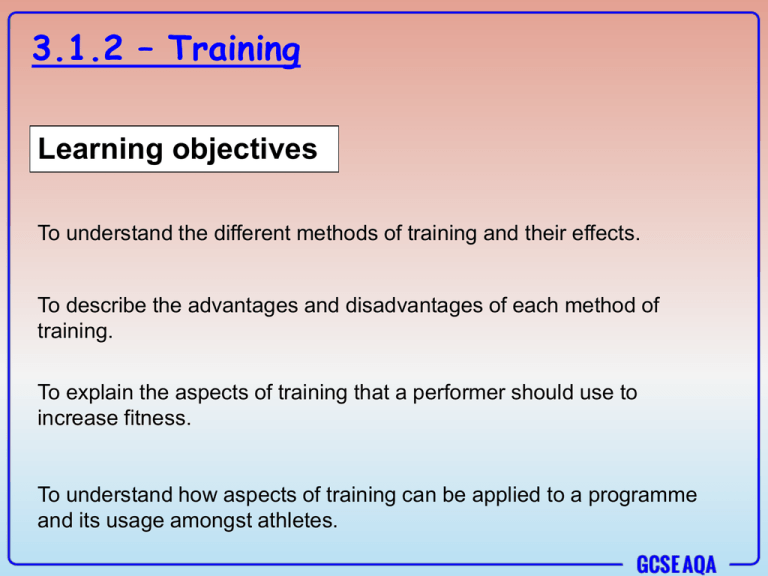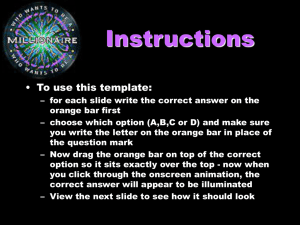Training PowerPoint
advertisement

3.1.2 – Training Learning objectives To understand the different methods of training and their effects. To describe the advantages and disadvantages of each method of training. To explain the aspects of training that a performer should use to increase fitness. To understand how aspects of training can be applied to a programme and its usage amongst athletes. Training There are many training methods a performer could use. Each method works the body differently. The aim of training is to improve: • Fitness • Skills •Techniques Maximum Heart Rate Each individual has a maximum heart rate. Maximum heart rate can be calculated below Maximum Heart Rate (MHR) = 220 – age So, a 25 year-old would have a maximum heart rate of - 220 – 25 = 195 bpm Weight Training WEIGHT TRAINING is a form of training that uses progressive resistance against a muscle group. How can weight training benefit a performer? 1. Increase muscular strength 2. Increase muscular endurance 3. Recover after injury. Weight Training Weight training can increase: Muscular strength: High weight x low repetitions Muscular endurance: Low weight x high repetitions Rest and recovery time will depend on: -Athlete’s fitness -Athlete’s weight -Sets completed 2 days is the average recovery period to mend damaged muscle fibres. Weight Training Pyramid sets: performer starts of light with more reps and works up to heavy weight and few reps. Weight Training There are 2 ways you can train: Machine Weights Free Weights What are the advantages and disadvantages of weight training using Machine Weights or Free Weights Weight Training Machine Weights Free Weights Positives: -Safe to use -Technically design to work specific muscle groups. -Always ready to use Positives: -Provides a wider range of movement. -can develop explosive strength (many top performer use free weights) Drawbacks: -Extra weight cannot be added. Drawbacks: -Need a spotter for safety reasons. -Injury is more likely to occur if posture is not right Circuit Training Circuit training is a series of exercises completed one after another. It is a very good way of developing general fitness. Circuit training can help to improve •MUSCULAR ENDURANCE •CARDIOVASCULAR FITNESS Circuits can be made specific by using skills from your chosen sport. i.e. basketball Stations could include: - Dribbling - Shooting - 1 vs 1 - Defending - Free throws What factors should you consider about the order of the activities and why? How can the intensity be increased? i.e. make it harder Circuit Training What are the advantages and disadvantages of circuit training? Circuit Training Advantages • Develops strength and endurance • Appropriate form of training for most sports • Can be adjusted to suit age, fitness and health of the athlete • Exercises are simple enough to make each athlete feel a sense of achievement in completing them. Disadvantages • Some exercises require specialised equipment e.g. dumbbells • Ample space required to set up the circuit exercises & equipment • Use of additional equipment requires appropriate health and safety monitoring Interval Training This training involves periods of work followed by periods of rest. i.e. Sprint for 20 metre + walk back to start. What athletes/performers would benefit from this method of training? Interval Training Lactic acid and oxygen debt builds up during interval training. The rest phase allows for recovery of these levels. What muscles group would this training help build? – think muscle types? What body system is working during this type of training? - Fast Twitch muscle fibres - Anaerobic – without air Example = 200m Interval Training Long Interval Training: Work time can range from 20 seconds to 3 minutes. Who might benefit from longer interval training? Used by games players and middle distance runners i.e. 400m X 5 with 2 minutes rest in between each set Interval Training Short Interval Training: Work time will be no longer than 20 seconds. Who might benefit from longer interval training? Used by sprinters and racket sport players due to short bursts needed. i.e. 50m X 7 with 2 minutes rest in between each set Interval Training What are the advantages and disadvantages of interval training? Interval Training Advantages • Improves cardiovascular fitness (Can mix aerobic and anaerobic exercise which replicates team games) • Improves heart efficiency • It will help train for a range of sports • Improves oxygen utilisation Disadvantages • Tough on your body (It can be hard to keep going when you start to fatigue) • Must leave sufficicent time to recover after a workout • Should be done under the supervision of a coach/instructor Fartlek Training Means ‘SPEED PLAY’. It is a combination of running, cycling speeds. i.e. 1 lap at 50% max, 1 lap walking, 1 lap at 80% Works on both aerobic and anaerobic fitness due to the varying intensities. What athletes may use this method of training? Fartlek Training - Used by team games performers as it suits the movements necessary for a game. - Can be completed over different terrains - woods / hills / roads to create a variety of intensities. Fartlek Training What are the advantages and disadvantages of Fartlek training? Fartlek Training Advantages Disadvantages • Good for sports which require changes in pace • Too easy to skip the hard bits • Easily adapted to suit the individuals level of fitness and sport • Can be difficult to see how hard someone is trying! Continuous Training Involves a steady but regular pace. i.e. Jogging. It is important to maintain heart rate in the training threshold (60-80% of Max). Activities can includes running, walking, swimming, rowing or cycling. Continuous Training What muscles group would this training help build? – think muscle types? What body system is working during this type of training? - Slow twitch muscle fibres - Aerobic – with air What particular athletes may use this method of training? Long distance events – Marathon Continuous Training What are the advantages and disadvantages of continuous training? Continuous Training Advantages • Needs only a small amount of easy to use, accessible equipment, if any • Good for aerobic fitness • Good for losing weight Disadvantages • Can be boring • Doesn't improve anaerobic fitness so isn't as good for team games like football or hockey which involve short bursts of speed EXAM QUESTION Write down 3 statements about each of the following methods of training. (a) Fartlek Training (b) Continuous Training (c) Cross Training Put the following statements under either one of the headings. Free Weights c) Not for beginners: d) Easy to work: e) Builds up strength: f) Limit to the amount of weight lifted: g) Injury due to poor technique: h) Seats and belts make them safe: i) Can help after injury: j) Move only in the designed way: k) Needs a spotter: l) Use on your own: m) Top sportspeople use them: n) Uses anaerobic and aerobic respiration: o) Easier to apply more weight: p) Always set up and ready to use Machine Weights Aspects of training There are certain ASPECTS OF TRAINING which should be followed in order to improve performance. Specificity Your training should be geared “specifically” towards your chosen sport or activity. You need to train specifically to develop the right… • muscles – if your sport requires a lot of running, work mainly on your legs. • type of fitness – do you need strength, speed, stamina or a combination? • skills – you need to practice any relevant skills like kicking, serving and passing. Specificity e.g.The training for a shot putter would be different from the training for a marathon runner……… You would not ask your shot putter to run 2 miles nor ask a runner to use heavy weight based exercises e.g. if you’re training for a weightlifting competition, it’s no use going swimming every day. You need to concentrate on strength training for your arms and legs. Specificity There is also a need for SPECIFIC TRAINING within a sport. e.g. goalkeepers need different training to outfield players. Progression This principle involves working the body harder than normal and gradually increasing the amount of exercise you do. This makes our body adapt to the training levels and therefore getting fitter. Progression Athletes need to monitor performance levels and adjust the programme in order to take fitness level to a higher level. How would you achieve progressive overload? Overload This principle involves working the body harder than normal and gradually increasing the amount of exercise you do. This makes our body adapt to the training levels and therefore getting fitter. Overload is closely linked with progression. What would happen if you overloaded your muscles to quickly? Overload: the FID principle There are four ways to achieve overload in an exercise programme. They can easily be remembered using the mnemonic, FID. • Frequency – how often you train. E.g. From 1 a week to 3 times. • Intensity – how hard you train. E.g. Working at 75 % of your max instead of 60%. • Duration – how long you train for. E.g. Training for 2 hours instead of 1 and a half hours. Frequency - How often we train The body needs time to recover from each training session. Training should be spread over the week and varied. Intensity - How hard we train Fitness gains are only achieved if the body systems work hard enough. Athletes must start at the right intensity, depending on our current fitness. An understanding of training thresholds also help. Duration - How long we train Each session must last at least 20 minutes to get any benefits. To improve AEROBIC fitness training sessions should last longer and working HR should rise between 60-80% of maximum. Reversibility Reversibility is process of an athletes body losing fitness levels. It the opposite of progressive overload and can occur if training has stopped due to illness or injury. This simply means that unless you keep training, any fitness gains will be lost. Athletes say..... “If you don’t use it, you lose it!” Reversibility This means that instead of progressing or remaining at the same level, the athlete loses fitness. It only takes 3 or 4 weeks to get out of condition. What implications does this have for an elite performer who’s season has just finished? When else might you see reversibility take place? Repetitions/Sets You can’t design a weight-training program without knowing two terms: Repetition - is one complete motion of an exercise. Set - is a group of consecutive repetitions. The number of repetitions and sets completed with vary depending on the programs focus (i.e. strength or endurance training) and intensity level of a workout Threshold To improve fitness from regular exercise you must push your heart rate above a certain level, known as the… “training threshold” There are two training thresholds: Aerobic Training Threshold = 60-80 % of the maximum heart rate Anaerobic Training Threshold = 80% + of the maximum heart rate Training Zones The type of activity an individual chooses will determine how easily they reach a threshold. Also, the performers current fitness level will decide how quickly they reach the training zones. Rest and Recovery For effective training performers should achieve the right balance between rest and recovery. Rest and recovery allows the body to: 1. Replenish energy stores 2. Repair muscles fibres Rest and Recovery TASK: What are the signs of overtraining? Summary Questions: Can you answer the following questions? Success Criteria: All pupils should be able to answer a minimum of 4 questions. Most pupils should be able to answer 5-6 questions. Some pupils should be able to answer all the questions. Summary Questions: What is Fartlek training? What is the difference between free weights and machine weights? Describe interval training. Circuit training can be made specific to a sport. What stations might you include in a basketball circuit? Summary Questions: What is overload and how can it be achieved? Describe and explain your understanding of an athlete’s aerobic training zone. What are the signs of overtraining? Explain the training principle of reversibility?





